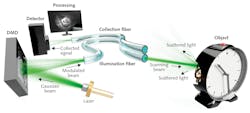Holographic endoscope could better treat severe brain diseases
Holographic far-field endoscopes could soon provide better understanding—and more effective treatment—of Alzheimer’s disease and other severe brain conditions, as well as aid in other biomedical applications.
Researchers at the Leibniz Institute of Photonic Technology (Jena, Germany) developed an instrument that uses holographic methods to reconstruct images of macroscopic objects placed in front of the far end of the endoscope.1 Holographic wavefront manipulation enables the conversion of hair-thin multimode optical fibers into minimally invasive, lensless imaging instruments, according to the study, and conveys much higher information densities than conventional endoscopes. The work was prompted by the technology’s potential to conduct minimally invasive observations inside the human body.
The endoscope observes macroscopic objects. In this study, imaging characteristics were studied at distances between 20 and 400 mm. Specifically, the researchers imaged inside the cavities of a sweet pepper commonly used as a phantom for biomedically relevant conditions. The image definition was boosted to 100,000 pixels per frame, which is an order of magnitude larger than previous holographic endoscopes and can also reach the definition of modern video endoscopes.
“We were positively surprised that the imaging quality was well maintained at larger imaging distances, even for objects placed at a half meter from the endoscope,” says Ivo Leite, a researcher in the Leibniz Institute’s Fiber Research and Technology department and holographic endoscopy group. “We expected that the low number of photons collected in this range would give rise to much higher detection noise.”
The study notes that as a region of interest is identified, users can update the spatial light modulator’s sequence display to switch the imaging modality and perform observations at the cellular and subcellular levels.
“The potential for such flexibility in imaging operation through the same unmodified endoscope is a unique feature that … holographic endoscopes could soon offer,” says researcher Tomas Cizmar, a professor and head of the Leibniz Institute’s Fiber Research and Technology department and leader of the holographic endoscopy group.
The endoscope features two parallel optical fibers: one for illumination and the other for signal collection. While accounting for light transport through step-index multimode fibers, the system is optimized for speed, power efficiency, and signal quality.
Compatible with a multimodal operation, it can dynamically switch from far-field imaging to detailed microscopic observations near the fiber by updating the holograms displayed by the spatial light modulator (see figure). The researchers found that both hologram sequences can be obtained via “two transmission matrices acquired simultaneously or numerically by multiplying either one with a free-space propagation operator.”
Using the far-field modality, the endoscope can be used to guide the insertion of the probe while providing organ- or tissue-scale imagery; this can, in turn, be converted into an instrument that images at the subcellular scale. Combined with spectroscopic imaging methods, the researchers say the technology also has potential for in situ diagnostics at the cellular level.
The light control methods used by the researchers could have applications in a range of areas, such as optical transfection, subcellular laser surgery, and laser-assisted microfabrication.
REFERENCE
1. I. Leite et al., APL Photonics (2021); doi.org/10.1063/5.0038367.
About the Author
Justine Murphy
Multimedia Director, Digital Infrastructure
Justine Murphy is the multimedia director for Endeavor Business Media's Digital Infrastructure Group. She is a multiple award-winning writer and editor with more 20 years of experience in newspaper publishing as well as public relations, marketing, and communications. For nearly 10 years, she has covered all facets of the optics and photonics industry as an editor, writer, web news anchor, and podcast host for an internationally reaching magazine publishing company. Her work has earned accolades from the New England Press Association as well as the SIIA/Jesse H. Neal Awards. She received a B.A. from the Massachusetts College of Liberal Arts.

